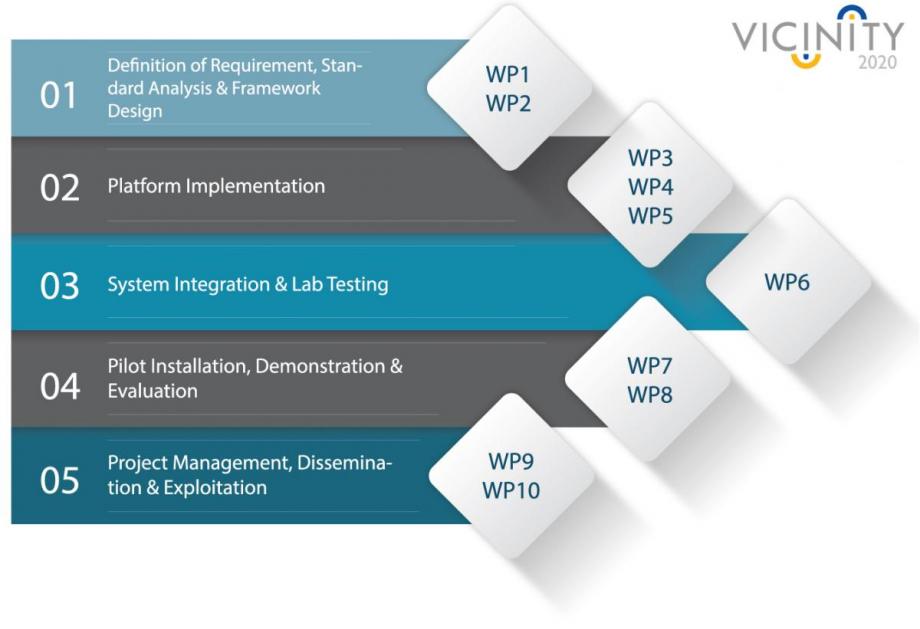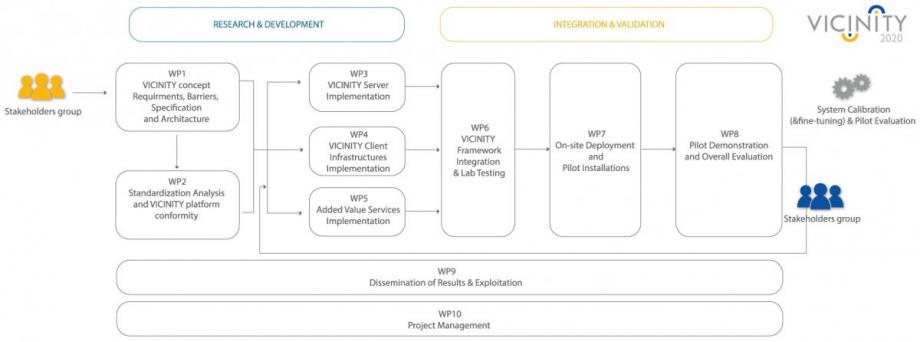VICINITY Methodological Approach
In the project, the ICT research and innovation will be confronted continuously and iteratively with the stakeholders’ group different requirements and the overall effectiveness of the investigated approaches. To this end, the involved stakeholders and end users of the developed system will be at the core of the project in all its phases starting from the definition of the requirements and the specifications up to the validation and assessment of the benefits of the proposed solutions (Stakeholder Advisory board). The project activities are linked with market research, technology assessment and user evaluation, new business modelling and sustainability planning for the project exploitable products. Therefore it is crucial that a clear and well-structured methodology is developed and followed throughout the lifetime of the project.

The overall methodology is consisted of the following interrelated phases:
Phase one (1): Definition of Requirement, Standard Analysis & Framework Design
The definition phase (consisting of WP1 & WP2) aims at establishing very early in the project the main foundation on which the rest of the project will be based. The underlying fundamental objectives to be addressed are:
- stakeholders group requirements and user acceptance criteria,
- further system requirements set by the extensive State of the Art analysis,
- refinement of the application scenarios and pilot use cases based on the extracted requirements,
- degree of availability of technological solutions and implementation feasibility,
- guidance for the deployment of technologies to the foreseen ICT demonstrations.
A user-centred (UCD) approach and iterative development with participation of end-users and relevant stakeholders in all phases will be applied to continuously guide and also validate project results. The extracted requirements (WP1) along with the standards analysis (WP2) will provide the basis upon which the detailed system architectural framework will be built.
Phase two (2): Platform Implementation
Building upon the main outcomes and guidelines of the Framework Design Phase, the current phase (consisting WP3, WP4 & WP5) realizes the technical development, implementation and configuration of Individual Components/Modules and more specifically:
- The VICINITY Server
- The VICINITY Client Infrastructures
- The envisioned Value-added Services
Updates and refinements will be applied to the respective technical developments after the feedback derived from the VICINITY platform continuous operation.
Phase three (3): System Integration & Lab Testing
In this phase (consisting of WP6), the VICINITY components will be integrated into a unified application towards their initial testing and validation. In particular, all the implemented methods and algorithms will be iteratively validated and optimized inside the laboratory, through ethically approved end user involvement when necessary. In this direction, controlled experiments will be held concerning validation of the interoperability performance among system components, communication interfaces and data manipulation methodologies.
Phase four (4): Pilot Installation, Demonstration & Evaluation
This phase (consisting of WP7 & WP8) aims to follow the outcomes derived by phase 3 and focus on:
- the execution of the efficient installation planning (WP7) in realistic environments performing the VICINITY system’s actual roll out and assessment. Thus, this phase involves the actual adaptation of the VICINITY framework into real-time conditions and operation of the pilot use cases.
- the overall realisation and evaluation of the individual use cases and the whole system, taking into account user experience and performance criteria, metrics and indicators clearly depicted via the establishment of a thorough evaluation framework.
Phase five (5): Project Management, Dissemination & Exploitation
This phase comprises all the horizontal, supporting activities of the project namely:
- Dissemination and Exploitation (WP9) where the prototype and the VICINITY components will be used for specifically targeted exploitation activities (e.g. website, publications, educational material, conferences, seminars etc.) during and after the end of the project, especially to SMEs.
- Project Management (WP10) consisting of all administrative management activities including the delivery interim and periodic reports to the European Commission as well as activities related to the financial monitoring of the progress of all partners.
The correlation of the different phases and consisting WPs are graphically presented below.

